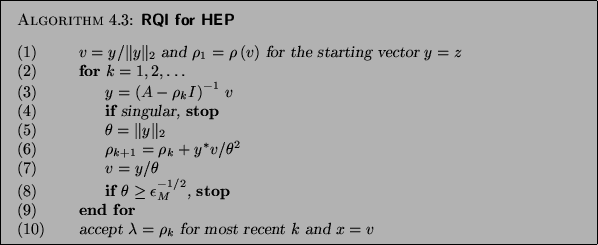A natural extension of inverse iteration is to vary the
shift at each step. It turns out that the best shift which
can be derived from an eigenvector approximation ![]() is the Rayleigh quotient of
is the Rayleigh quotient of ![]() , namely,
, namely,
![]() .
.
In general, Rayleigh quotient iteration (RQI) will need fewer iterations to find an eigenvalue than
inverse iteration with a constant shift; it ultimately has cubical
convergence, while inverse iteration converges linearly. However, it
is not obvious how to choose the starting vector ![]() to make RQI
converge to any particular eigenvalue/eigenvector pair. For example,
the RQI can converge to an eigenvalue which is not the closest to the
starting Rayleigh quotient
to make RQI
converge to any particular eigenvalue/eigenvector pair. For example,
the RQI can converge to an eigenvalue which is not the closest to the
starting Rayleigh quotient ![]() and to an eigenvector which is
not closest to the starting vector
and to an eigenvector which is
not closest to the starting vector ![]() . Furthermore, there is the tiny
but nasty possibility that it may not converge to an
eigenvalue/eigenvector pair at all. RQI is more expensive than inverse
iteration, requiring a factorization of
. Furthermore, there is the tiny
but nasty possibility that it may not converge to an
eigenvalue/eigenvector pair at all. RQI is more expensive than inverse
iteration, requiring a factorization of ![]() at every
iteration, and this matrix will be singular when
at every
iteration, and this matrix will be singular when ![]() hits an
eigenvalue. Hence RQI is practical only if such factorizations can be
obtained cheaply at every iteration. See Parlett [353] for
more details.
hits an
eigenvalue. Hence RQI is practical only if such factorizations can be
obtained cheaply at every iteration. See Parlett [353] for
more details.
